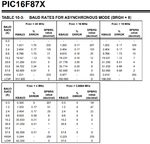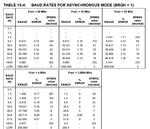engr_joni_ee
Advanced Member level 3

Hi,
I have tested PIC 16F876 with 57600 which works fine. However it fails at 115200. Is this a limit ? Is it possible to use 16F876 with 115200 ?
I have tested PIC 16F876 with 57600 which works fine. However it fails at 115200. Is this a limit ? Is it possible to use 16F876 with 115200 ?



